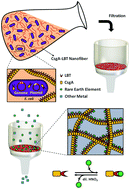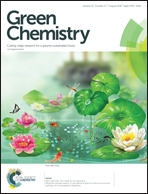Repurposing bacterial extracellular matrix for selective and differential abstraction of rare earth elements†
Abstract
The rare earth elements (REEs) play critical roles in modern consumer electronics and clean technologies, but unpredictable supply and environmentally unsustainable extraction practices have spurred efforts to develop green methods of recovering the metals from waste streams. In this regard, we have repurposed a bacterial extracellular matrix (ECM) for selective and differential abstraction of REEs. Herein, the curli amyloid fibers in E. coli biofilms are genetically modified to display lanthanide binding tags (LBTs). The curli-LBT filters showed lanthanide specificity in the presence of other metals, with a preference for binding several high-value heavy REEs. Bound lanthanides were readily recovered using a dilute acid wash, and the filters could be re-used for multiple cycles of sorption and desorption with minimal loss of efficiency. Our engineered biofilm-derived filters provide a rapid, selective and scalable method for REE separation that is more robust compared to conventional cell-based sorbents, and this platform could be adapted to recover other precious metals or commodities.

- This article is part of the themed collections: Precious Elements and 2018 Green Chemistry Hot Articles


 Please wait while we load your content...
Please wait while we load your content...
